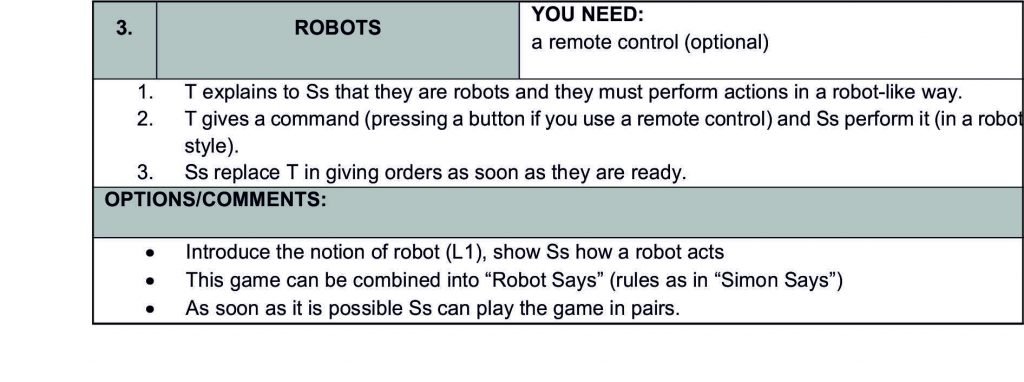In the previous article dedicated to teaching pre-school children we presented a few techniques and some practical advice on how to maintain discipline and keep students focused during the lesson. (This series was first published in the Teacher Magazine in 2013/14). Here we are going to deal with motivation and rewarding in a YL classroom.Children will follow your instructions, perform tasks, enjoy the lessons and engage in activities only when they are motivated. “Do it because I say so” does not work! Motivation is one of the crucial things teachers must remember about in the classroom. We will try to show how simple commands may become motivating and fun though action games.
CBG (Catch Them Being Good) is the golden rule in motivating children.
Always see the good sides of children. Rather than telling them off, praise them and reward them, it can work miracles.
1. PRAISING
The first, the simplest and the most successful way to motivate kids is to praise them – as simple as that. You do not really need special gifts or rewards – sincere words can do miracles!
- Children need to be appreciated as they need confirmation that they are doing well. Your job is to find things you may admire your students for the whole group or individual students.
- Praising should be one of your routines and natural things you do. Remember: there is never too much of it in a young learners’ classroom.
- Even if a child is naughty and disturbs the lesson, praise the moment when he or she takes an active part in an activity (CBG!)
- If you have got a very quiet child in your group, you may tell the child that you appreciate him or her for being good and behaving well (CBG!)
- Repeat frequently: You were great today! Wow! You’re doing really well! Fantastic! and other approving expressions.
- If you have the opportunity, tell the parents how proud you are of the group. Both students and parents will feel greatly motivated. It is also good to pick a few kids to praise to their parents individually after a lesson, this really gives them a lift. Remember to pick different children after every lesson, so that all of them are eventually praised.
However, once you get used to praising students regularly, there is the danger that you will start to treat it as a routine, reflex reaction – with an indifferent voice and empty look. Remember that praise works only if it is true and you express it with some true emotions. Beware also of overusing praise. Some teachers forget what it is really for and out of habit say the words of praise all the time – even if a child does something inaccurately.
2. REWARDS / POSITIVE ENFORCEMENTS: 
- if you have a class mascot (and we do recommend using one with YL) use it to kiss or give a handshake to students (girls prefer the former, boys the latter)
- everybody claps their hands when the group (or some students) do well
- teacher or the class mascot gives students a “high-five”
- teacher does something that is usually done by students (especially in a funny way) – students can give orders to the teacher (students become teachers, captains or bosses – kids love it!)
- stickers (in the book or on students’ clothes)
- stamps (in the book or on body parts)
- pluses/smileys/flowers collected on the board or a sheet of paper during the lesson. Students collect them as a group (NOTE: there are only pluses, do not give minuses in this age group as they are very demotivating). At the end of the lesson count the items with all students, praise them and reward them with something, e.g. stamps or stickers.
- sweets – only for special occasion!
- colouring pages with e.g. children’s favourite characters from a cartoon. You will find lots of them on the Internet.
If your small students are enthusiastic and motivated and they eagerly join in all the games and activities, the activities are a reward in themselves. There is no need to give children special rewards then. You had better keep them up your sleeve for when you need a special motivator.
External motivation is important, however, the process of building internal motivation and arousing the joy of achieving goals is much more vital. Internal motivation lasts longer and works miracles
3. TAKING OVER BY YOUNG LEARNERS
This is, as we believe, the first step in building internal motivation. Taking over during the lesson and stepping into teachers’ shoes is really exciting. Students feel that they have impact on the course of action which motivates them more than a fancy sticker. Playing the part of the teacher is precious and memorable for students. Below you will find a few simple action games where tips are given on how to let students take over.
We suggest that you introduce some or all of the games below; make sure you practise each of the games with your students a couple of times. As soon as they know the rules a student should take the lead. As kids may sometimes run out of ideas it is useful to have some flashcards prepared with the pictures representing some more complicated actions.
CLICK FOR THE NEXT EPISODE OF THIS SERIES.
If you like this article, let us know! Comment, like or share! Thank you!





